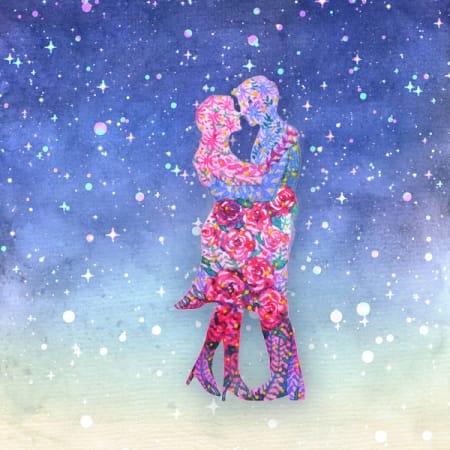Description
Lover Archetypes Class
LISTEN TO SAMPLE
All three archetypes, the Lover, Don Juan, and Femme Fatale have the following in common. They are:
- Concerned with matters of the heart
- Preoccupied with romantic relationships
- Seduced by the need to control a romantic partner
- Invited into realizing cosmic love
- On a journey from separation to union in love
Most people associate these three archetypes with romantic relationships and the subsequent fallout. Broken hearts, wars, great music, and art originate from what we call love. However, the impact of the Lover, Don Juan, and Femme Fatale goes well beyond private love affairs.
“The Lovers” archetypes change the course of human history not just because of the crazy things people do for love but because of how these archetypes open us to cosmic love. Each archetype carries the potential for holy love that transforms us, personally and collectively.
The Lover, Don Juan, and Femme Fatale strive for an honest and unbound connection. Free of polarization, the hearts of these archetypes align with what’s sacred and whole. The journey is not easy because matters of sex, sexuality, power plays, and intrigue threaten to consume us at every turn. The temptation to gain control over others is strong.
People with the Lover, Don Juan, and Femme Fatale archetypes naturally tend to get caught in romance dramas and games. They seek consummation, a coming together. In the shadow, they want their partner to give to them completely, to surrender to the relationship. In the light, these archetypes surrender to love itself.
“The Lovers” class makes evident the interplay between romantic partners. What once was involuntary now becomes a conscious choice. Stacey teaches that through this interchange, love is no longer something that “just happens.” Love becomes an active principle, a life force, a grace that consumes and transfigures us.
Lover Archetype
When ruled by her ego and material concerns, the Lover archetype believes love is a noun, a state of being that she needs to occupy, a person that she must possess. To the undeveloped Lover, love is involuntary. She believes she has no choice when or if love happens, and this makes her crazy for love.
The shadow Lover mistakes love for limerence. Limerence is defined as preoccupation with another person and an intense desire for reciprocation. The limerent lover needs to be wanted as badly as she wants the other. Limerence includes being love-struck, blinded by love, love drunk, and lovesick.
The Lover’s life falls apart when she becomes consumed by limerence’s wild emotions and intense swings of doubt and hope.
Eventually, the heartbreak becomes unbearable, and the Lover questions her definition of love. She gives up the belief that love is dependent upon romances and stops confining love to specific “special” relationships. The Lover explores all the places and ways love is available, including within herself.
Next, love becomes an active choice, a verb. The Lover realizes that she doesn’t have to wait for love to choose her; she can choose it, which changes everything. The love from her cosmic-sized heart has a vessel large enough to pour into – the people and world around her.
In the fullest expression of the light, the Lover surrenders completely to love. Love is the only choice because she can’t bear being unloving. The Lover meets the Beloved and becomes Love.
Don Juan Archetype
“Don Juan” was first used in 1630 to describe a charming man who seduces women and breaks sexual taboos. Don Juan was the protagonist in “The Trickster of Seville,” written by Tirso de Molina in Spain. Every synonym for the Don Juan archetype, including Casanova, womanizer, ladies’ man, and Lothario, comes from the same period.
There is no historical evidence of a Don Juan archetype before the 16th Century. By definition, an archetype must be universal and timeless. To uncover the true nature of the Don Juan, we need to trace him back to the beginning of human history.
In this class on “The Lovers,” Stacey Couch weaves a compelling story of the Don Juan’s birth. She posits that the Don Juan archetype is a progeny of the Trickster archetype. By comparing modern Don Juan stories with ancient trickster tales and lost erotic folklore, Stacey reveals new faces of the Don Juan.
In his undeveloped state, the Don Juan exposes patriarchal hypocrisy by playing tricks. Misogyny and elitism annoy him, so he breaks taboos around marriage, sexuality, and classism. He turns honor on its head by building a reputation for doing dishonorable things.
The immature Don Juan mistakes trickery for charm. He believes that women can’t resist him and relies on deceit, lies, prestige, and glamour to woo lovers.
The Don Juan evolves when he sees that the trick is on him. He has used his power, status, and wealth to harm others. His misogyny has affirmed the very system he loathes. The Don Juan turns inward and self-reflects. Before, he’d practiced self-limerence, a type of narcissism, now he makes an honest effort to know and love himself.
As the Don Juan opens to love, he realizes that the real trick is to give up the games and be loving. Honesty is the most effective way to thwart a power-hungry society. An expert at discerning true consent, his natural charm attracts the truth. In the fullest expression of the light, the Don Juan brings the radical love that foils the brutal desire for power.
Femme Fatale Archetype
The Femme Fatale or the fatal woman is often mistaken for a cliché. She’s viewed as a siren who uses sexuality to lure, seduce, and destroy men. This superficial stereotype keeps her in exile. Few people feel they can relate to this archetype.
The Femme Fatale archetype’s origins reveal her universality. She traces all the way back to the first woman. Lilith, Eve, and Pandora’s stories show that women were targets of vengeance before they became aggressors. The Femme Fatale is not a woman with agency but a woman stripped of it.
“Slut” is today’s term for the Femme Fatale. By examining the disturbing rise of slut-shaming and slut-bashing we see that the Femme Fatale is alive and well. As long as the sexual double standard and rape culture persists, the Femme Fatale will be targeted by powerful people. Still, she endeavors to emerge as a survivor.
In the light, the Femme Fatale embodies the feminist movement throughout history. She is the rise of the feminine, confronting patriarchal abuse, restoring agency by unmasking her abusers, and ultimately lifting the veil on sexism globally.
The Femme Fatale is initially exiled, outcast, and alone. She moves into the light by forming a sisterhood with other survivors. The #metoo movement and other organizations seeking gender and sexual equality have the Femme Fatale archetype at their core.
The Femme Fatale lives a fully examined life, confronting double standards and inequalities within. She brings the feminine and masculine and the destructive and creative capacities into right, loving relationship. Despite her suffering and every reason to be vengeful, the Femme Fatal in the light choses love. She regains her power through the agency of love.
Included:
In this online class, “Lover Archetypes: Lover, Don Juan, Femme Fatale,” Stacey Couch gives an in-depth definition of the light and the shadow of the Lover, Don Juan, and Femme Fatale archetypes. Stacey describes the main themes of each archetype, so you can recognize and tell them apart. You get concrete examples of each archetype’s expression, showing how to identify these archetypes in yourself and others.
You receive a course workbook with journal questions and summaries of key points, which deepens your knowledge and understanding of which archetypes you are working with at any given time.
Stacey shares spirit animals and powerful prayers for each archetype.
She draws from fairytale, mythology, history, science, spiritual teachings, old and new, and modern television and cinema. The good news is that you don’t need to read or watch it all. Stacey synthesizes, extracts, and adds to the content, making it easily accessible.
For those of you who want to dive deeper, Stacey includes a host of resources across a wide range of disciplines so you can read and watch to your heart’s content. All the information is organized in an elegant, accessible format. Stacey’s teachings are superbly researched.
Although the Femme Fatale and Don Juan are typically presented as gender-specific, Stacey discusses how people of any gender or sexuality embody these archetypes.
Course Outline:
This four-part pre-recorded audio course covers the following:
Introduction to the Definition of Archetypes (for beginners)
Session 1: Lover Archetype
- Love as limerence
- Seven stages of limerence
- Shadow of unrequited Lover
- Love as a noun
- Anxious attachment style
- Kaleidoscope of love
- Safe outlets for limerence
- Cultivating self-love
- Love as a verb
- Positivity resonance
- Love as surrender
- Lover’s spiritual union
Session 2: Don Juan Archetype
- Origin of the term “Don Juan”
- Descendent of the Trickster archetype
- Trickster tales and the Don Juan
- Birth of a new archetype
- Playing with honor and reputation
- Shadow of misogyny
- Stories of Bluebeard and King Shahryar
- Story of Narcissus and narcissism
- Taboo breaking today
- Reflecting on hypocrisy
- Developing true self-love
- Expert at authentic consent
Session 3: Femme Fatale Archetype
- History of the Femme Fatale
- Women as vessels of vengeance
- Victim of abuse of power by those in power
- Femme Fatale’s need for revenge
- Killing off the creative self
- “Slut” as today’s term for the Femme Fatale
- Sexual double standard
- Embracing curiosity and creativity
- Feminist movement
- Lifting the veil on abuse
- Sisterhood
- A fully examined life
Session 4: Discerning Between the Lover Archetypes
- What the Lover Archetypes have in common
- Unique ways each archetype plays hard to get
- Different paths to consummation
- TV and movies that contain all of these archetypes
- Famous mystic “Lovers”
- Each archetype through four stages of evolution
For Mature Audiences Only – This course contains explicit material and is intended for mature audiences (users over the age of 18) only.
What are Archetypes?
Archetypes are universal patterns of nature. When speaking of archetypes in a human context, archetypes are templates of human nature. They coordinate how we think and feel. All we have to do is say “angel” or “hermit”, and instantly, others know what kind of person we are talking about. This is indicative of how ubiquitous each archetype is. The Greek origin of the word “archetype” comes from the words archē, meaning “beginning or original” and typos, meaning “pattern, model or type”. Thus, an archetype is the original or first pattern from which all others are made.
Click Here to Learn More About Archetypes
Refunds
Due to the nature of this offering where audio files are available for immediate download, refunds are not available.




Reviews
There are no reviews yet.